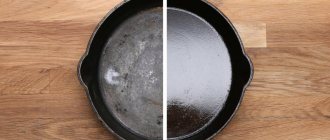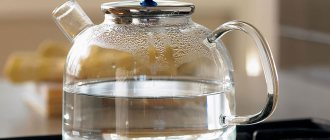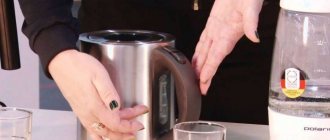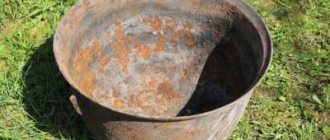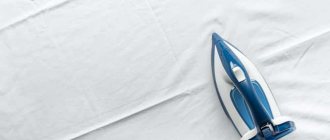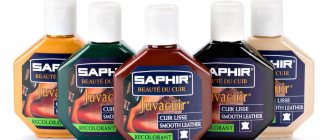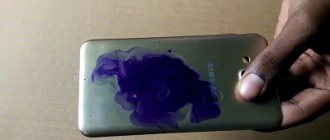Why is it bad when the kettle rusts? How to clean the inside of a kettle from rust? What not to do when cleaning a kettle? How to prevent rust?
The metal parts of the electric kettle may rust. This happens, firstly, due to the fact that iron is oxidized in combination with oxygen and water. Hard water plays a role, which contributes to the appearance of scale on the walls and parts of the device. How to clean a kettle from rust without damaging the equipment? Is it necessary to remove it at all? We'll tell you in this article.
How to clean a kettle
You can get rid of iron oxides in the form of dark deposits in a teapot in different ways, the main thing is to use them correctly. The most effective way to deal with the problem is citric and acetic acid. These are organic acids that do not have a very strong effect on the metal. At the same time, they easily remove loose deposits formed on its surface.
We use acetic acid
This is one of the simple and affordable means with which you can deal not only with rust in the kettle, but also with scale.
- You need to prepare table vinegar 6–9%.
- Fill the container three-quarters full with water.
- Bring water to a boil and turn off.
- Pour in the vinegar solution in the amount of the missing quarter of the kettle's volume.
- Leave for eight hours or leave overnight.
- Drain the solution and rinse thoroughly several times with water.
The smell of vinegar is very persistent; to get rid of it, you may need to boil several new portions of clean water.
In severely advanced cases, one procedure is not enough. Therefore it will have to be repeated.
Only steel teapots can be cleaned with acetic acid; plastic ones can be damaged. They are cleaned with the addition of baking soda:
- pour water, vinegar and add one tablespoon of soda;
- as soon as the violent effervescent reaction ends, the resulting liquid is allowed to boil and, after cooling, is poured out;
- Finish cleaning by rinsing with clean water.
Cleaning with citric acid
Unlike vinegar, citric acid does not have a strong odor. Therefore, when choosing a method to combat rust, preference is given to it.
The cleaning procedure is carried out in the same way as with acetic acid, but with some simplification. Fill the kettle completely with water, bring to a boil and add 1-2 tablespoons of citric acid. After cooling, the solution can be drained, wiped inside with a soft sponge, rinsed thoroughly with clean water and boiled clean water again. If rust appears on the outside, it can also be cleaned with a solution of citric acid.
You can replace powdered citric acid with lemon fruit. To do this, just cut it with the peel and boil it in a kettle for 10 minutes.
The use of citric acid and vinegar was recommended by well-known manufacturers of household appliances.
The appearance of rust in the kettle
The population who has access to high-quality water in all respects is incredibly lucky. Many people have to use hard water with a high content of various mineral salts and trace elements for drinking and cooking. If there is a lot of iron in the water, a coating of rust will certainly form on the walls of the pots and in the kettle.
Why should you delete
Just a few boils of water are enough for this rusty deposit to form on the inner wall of the kettle. In addition to the unpleasant appearance inside, there are other reasons why you need to clean the rust:
- A specific taste appears that does not allow you to enjoy the aroma of freshly brewed tea or coffee.
- In electrical appliances, deposits on the heating coil interfere with heating. The boiling time increases by an order of magnitude.
- Many housewives throw away a working kettle only because of brown rust inside.
Preventive measures
To prevent rusting use:
- bottled drinking water;
- purified in filter jugs using cassettes that remove iron;
- water from filtration systems.
When operating water heating devices, it is necessary:
- discard unused boiled water;
- pour water only before boiling;
- wash and dry the kettle once a day;
- clean rust stains;
- do not use abrasive products.
Removal from an enamel kettle
Enameled teapots require careful handling. You cannot scrape them with a knife or metal brushes. In places where the enamel chips, rust begins to appear. Over time, plaque spreads inside the dishes and leads to cracks.
Traditional methods
It is better to clean the internal container of the kettle with those chemicals that are constantly used in everyday life. They will help you tidy up your enamel-coated kitchen utensils.
Fruit and vegetable peels
Potato peelings, apple and pear peels are used to clean enamel dishes. Place the washed pieces into a container, pour in water and put on fire. Boiling for a few minutes will leave the utensils clean. If rust has just appeared, you can wipe the damaged areas with a piece of apple or half a potato soaked in vinegar.
Spoiled milk
Acid forms in soured milk. It can successfully wash off the rust that has appeared inside the kettle. You can wipe the stains with the product, leaving them for 5-7 minutes. Then scrub thoroughly with a sponge and rinse with clean water.
Lemon acid
Citric acid crystals fight rust stains inside cookware. You need to wipe the damage with a piece of lemon. Then wash off with clean water. You can get rid of plaque with a solution prepared from water and 2-3 tablespoons of citric acid. Boil water in a kettle for 30 minutes, then rinse under the tap.
Vinegar
The essence is poured into water, diluted in a ratio of 1:10. Boil in a kettle for 20 to 30 minutes. Then wash the kitchenware thoroughly to get rid of rusty deposits inside.
You can remove rust from enamel with a mixture of baking soda. For the procedure, use a damp sponge or cloth. Finally, rinse the inside of the kettle with water.
Industrial products
Rust and deposits from the walls of kitchen utensils can be removed using products such as Pulsar Kalk Free. It is enough to take 30 ml of concentrate per liter of water. Apply the liquid to the rust area and leave for 5-7 minutes. Then wipe with a sponge and rinse.
A mixture of mineral and organic acids of the Antirzhavin preparation can easily remove various deposits. The concentrate is applied to damaged areas, washed off after 7-10 minutes. After use, the product leaves a film on the surface that will protect against subsequent corrosion.
Types of pollution
Over time, an aluminum, enameled, stainless steel or any other metal kettle becomes covered with a thin film of grease and ordinary household dirt. If there is a gas stove in the house, you will also have to scrub off the carbon deposits that burning matches leave on the surface when the burner is lit.
Pollution should be dealt with comprehensively, since standard household chemicals and folk recipes can remove all types of pollution at the same time.
Folk remedies for rust
Home remedies that have been tested over the years are the safest in the fight against scale and rust. Particularly suitable for plastic teapots.
Lemon acid
Acid is one of the mildest agents. It can be bought at a regular grocery store in 25 gram bags. The composition for treatment includes: 10 grams of acid per 1 liter of water or pour 1 sachet into 1 full kettle. Then turn on the device.
The liquid is brought to a boil and the kettle is turned off. If the cleaning steps are not followed correctly, boiling water may begin to foam and, as a result, splash out. Leave the hot solution to cool for 15-20 minutes. After this time, pour out the solution.
Note! The remaining solution cannot be used for other purposes. Rinse the kettle thoroughly inside and out; if it is heavily soiled, repeat the procedure again.
Acetic acid
It is an effective reagent for removing rust, since when it reacts, it breaks down salts into simple substances. The method has been used for many years and is called “grandmother’s”. A 10% solution, which can be found in any kitchen, is suitable for the procedure.
The proportions for a regular kettle with a volume of 1.5-2 liters are equal to 2 glasses of vinegar. Then all the steps described in the previous method are performed.
Note! The disadvantage of this method is the smell, so you need to take care of ventilating the room in advance.
Soda solution
Dilute baking soda with water, the result should be a mass with a thick consistency. Apply the paste inside the kettle for 20 minutes. Then, using a steel bristle brush or steel wool, scrub the surface.
Coca-Cola sparkling water
The use of soda in the fight against scale
The most unexpected, but effective way. The drink contains orthophosphoric acid, which can cope with a large layer of scale. With this cleansing, it is not necessary to boil the kettle; it is enough to leave it with soda inside for several hours.
Important! The condition is that using this method you need to take a high-quality drink without dye, otherwise you will have to wash the paint off the walls of the kettle. Tips and tricks for caring for heating appliances
Tips and tricks for caring for heating appliances
Preventing rust is easier than looking for elimination methods. It is not difficult to follow a few rules and in this case you can be sure that you will not encounter this problem at all.
Adviсe:
- boil filtered or distilled water;
- after preparing hot drinks, do not leave excess liquid in the kettle;
- rinse the kettle after use;
- Carry out preventative cleaning of the device every month.
Note! Thus, there are many ways to remove even the most difficult deposits, but the solution to the problem is preventing the appearance of rust. *Prices are current as of August 2019
*Prices are current as of August 2022.
The effect of rust on the human body
Rust is a combination of iron and oxygen. Both elements are beneficial for the human body separately. After all, with a lack of iron in the blood, anemia occurs, which manifests itself as inhibition of vital processes in the body. But the oxidation of iron inside the teapot leads to the fact that harmful substances get inside a person when he drinks tea. Lingering in the body, iron oxides or salts irritate the gastric mucosa. Rust causes skin rashes, allergic reactions, and hormonal imbalances. It is dangerous for people with kidney failure to drink such water. Particles of rusty sediment cover the walls of the kettle, rendering the dishes unusable.
Reasons for education
As a result of a chemical reaction when water, oxygen (or moisture) and iron combine, the metal oxidizes.
If rust is found inside the kettle, its appearance can be caused by several reasons:
- Incorrect care . Metal must be dry outside of use. If there is always water left in the kettle or it is not wiped dry, expect rust. It is necessary to regularly clean the utensils both outside and inside.
- Water with a high percentage of metals . Rust can simply settle in spots on the bottom of the kettle, even if it is made of stainless steel. The reason is the oxidation of metals contained in tap water. It is advisable to use filtered or bottled.
- Poor quality kettle , poor protective enamel layer. If technological standards were violated during production, the coating was damaged (even slightly), or low-quality materials were used, this can lead to the fact that the inside of the kettle will begin to rust during operation.
- Aggressive actions of owners . Unknowingly, some people begin to descale kettles, wash off rusty spots using coarse abrasive substances and iron sponges, thereby simply peeling off the enamel.
- the dishwasher is not used properly, it can also cause damage to metal products. If you do not open the door immediately after the end of the cycle, it will be hot and humid inside for a long time - ideal conditions for accelerating the process of rust formation. If you do not soften the water with special salt, then impurities will stimulate the oxidation process. And the most amazing thing is that if there are red stains on some piece of dishes, then during washing they will transfer to other dishes.
If rust does appear in the kettle, you need to get rid of it urgently. This is quite easy to do at home.
Effective ways to clean rust from a kettle
Humanity has not yet invented more reliable, effective and safe ways to remove red-brown plaque from kitchen appliances than traditional, time-tested methods
What is important is that they are absolutely harmless to health, since they do not involve the use of chemicals. Folk remedies will not hurt your pocket, because in most cases everyone has everything they need at home
Vinegar
Apple and table vinegar 6-9% are suitable for cleaning. In a problematic kettle, it is necessary to boil water to 3/4 volume. Pour the remaining portion with vinegar and leave the kettle for 8 hours. Then pour out the contents and rinse the inner surface with clean water. The same effect can be achieved by using 3 teaspoons of vinegar essence per 1 liter of water. The procedure is the same.
Lemon acid
Citric acid can cope with the most severe and old rust. You will need 1 or 2 packages (depending on the degree of contamination). Pour them into a kettle, fill them to the top with water and boil for 20 minutes. Drain and rinse. An alternative to citric acid is freshly squeezed lemon juice (1 bag = 1 lemon).
Soda
To clean the kettle, you need to fill it with water to the middle, add 2 teaspoons of soda and boil for half an hour. Drain the water and rinse the dishes thoroughly. Leave the electrical appliance with the solution until it cools completely.
Kefir
Pour 1/3 of the volume of kefir into the kettle, boil, and leave until it cools completely. Drain and rinse the utensils thoroughly. Kefir can be replaced with sour milk - the effect will be no worse.
Brine
Pour cucumber or tomato brine into a bowl to the very top, bring to a boil, remove from heat and let cool. After cleaning with brine, the kettle must be washed thoroughly to eliminate the specific odor. Brine is indispensable for removing rust from metal utensils.
Carbonated drinks
Oddly enough, Coca-Cola, beloved by many, is an excellent remedy for fighting rust and scale. Fanta and Sprite are from the same series. Just pour the drink into the kettle overnight. In the morning, drain the liquid, wipe the dishes with a hard (not hard!) sponge and rinse with water.
Vegetable and fruit peeling
Peels from potatoes, apples and pears are an unexpected but effective way to remove plaque from kitchen utensils. The peelings need to be washed, placed in a kettle, filled with water and brought to a boil. Leave for 3-6 hours depending on the degree of contamination. Then remove the treated water, add clean water, boil and drain.
Rust can be removed using special products, which can easily be found in a large selection at any household chemicals store.
Regular washing powder is also suitable for these purposes. It needs to be applied to the rust, moistened and left. After half an hour, rub the problem area with half a raw potato. After this procedure, the kettle must be thoroughly rinsed and boiled several times, changing the water.
This also applies to any other chemical cleaning product: after using it, the dishes must be boiled at least 3 times. This is done so that the remnants of the product are removed and do not get into the tea and then into the human body.
What to use?
Both the internal and external surfaces of the heating device are subject to treatment. Inside, as a rule, only limescale accumulates, but on the outside the body is covered with dust, splashes and drops of grease , which also need to be removed.
How to wash the inside?
Dealing with scale inside the kettle is allowed only with means that are not hazardous to health. We are talking about components that are edible or used for cooking.
These are soda and citric acid, carbonated drinks and vinegar, brines and fruit infusions. Such folk remedies will definitely not harm your health - they are time-tested and safe.
But it is prohibited to wash the inside of the kettle with aggressive chemicals - you can easily get poisoned.
Mine outside
The chemical requirements for cleaning the exterior of the housing are not too stringent.
An excellent way to clean the outside of a stainless steel device is with regular toothpaste.
A small amount is squeezed onto a toothbrush and the contaminated areas are scrubbed locally. If you need to clean the entire body, the paste can be applied to the hard side of a dishwashing sponge and walked over the entire area.
Baking soda can easily replace toothpaste . Dip a cloth into the powder and wipe the kettle in a circular motion. This method is good for both metal and plastic units.
Activated carbon is another affordable and effective remedy. 10-15 tablets should be crushed into powder and applied to pre-moistened outer walls. Leave for about an hour and rinse with clean water.
Original ways to remove rusty plaque
Some housewives clean teapots using improvised means. If the rust is barely noticeable, you can get rid of it in the most unusual way:
- Pour washing powder onto a damp surface and leave for 20 minutes. Then rub well with half a potato. After thorough rinsing with water, the kettle is ready for use.
- You can clean the rusty coating inside with Coca-Cola, just pour the drink over it and leave it overnight. All that remains is to rub with a sponge and soap and rinse with water.
- Using brine from canned cucumbers or tomatoes can also clean rusty deposits in a metal kettle. The amount of vinegar or citric acid in these vegetables when canning is quite enough to carry out this procedure. You need to pour it into the dishes, bring to a boil, then cool, drain, and wash thoroughly until the specific odor is completely removed.
- Sour milk can also clean the kettle. It is enough to fill one third of the volume, boil and leave for a while.
The folk method is to clean rust and scale by peeling potatoes, apples and pears. The washed peelings are placed in an enamel or steel kettle, water is added and heated to a boil. Then turn it off, leave it for several hours, drain everything and boil it with clean water. All formations inside the dishes are washed out.
To prevent rusty deposits from appearing in the kettle, rinse it after each boil. If the water is hard and it is confirmed that it contains high iron content, it is better to install a filter at home. To treat yourself to a fragrant cup of coffee or tea, use bottled water.
The main causes of breakdown of water heating devices are the formation of rust and scale. When water is boiled in a rusty container, drinks develop an unpleasant metallic taste. We will tell you how to clean the inside of an enamel and electric kettle from rust, as well as the reasons for its appearance and prevention.
Rules of care
In order for the kettle to serve for a long time and help you enjoy delicious tea or coffee, you need to:
- use only soft or filtered water for boiling;
- drain water from dishes after using them;
- do not turn on the device if there is no water in it;
- do not open the electrical appliance when the water is boiling;
- clean utensils every week, washing not only the outside, but also the inside;
- Clean the spiral inside the device constantly if the water in the house is hard;
- do not scrape the walls and bottom of the cookware with a knife or metal brush;
- Use the item carefully to avoid damage to the walls.
When purchasing an enamel teapot, you need to know how to preserve it. It will last longer if you fill it with salt water (2 tablespoons per liter of water), bring to a boil and let the container stand until it cools completely.
You need to handle an enamel-coated item with care, because it has many advantages. The advantages of enamel coating are that it is resistant to acids and alkalis. In addition, water boiled in such a container does not lose its taste. If you use an enameled electric kettle correctly, it will last for several years.
Is it possible to avoid scale formation?
First you need to understand what causes scale to form. These are salts and minerals that are necessarily contained in tap water, and when heated, they disintegrate and settle on surfaces in the form of limescale. The harder the water, the more intense the scale will form, and additional softening will only delay the unpleasant moment, but will not get rid of it.
In an ordinary kettle - enameled or metal, plaque settles on the bottom and inner walls, which causes rust that corrodes the metal. In electric kettles, scale accumulates on the heating element in contact with the water, which leads to its breakdown.
Try to prevent limescale from forming in the kettle
So that you don’t have to clean your kettle for too long over time, or even replace it with a new one, use a few preventive tips:
- do not wait until the layer of scale becomes too thick, a smaller amount of sediment is much easier to remove;
- Rinse the kettle every day by wiping it with a sponge;
- use soft water for boiling, purified through a filter, and if possible, purchase it in gallons;
- do not boil the water again - this will significantly increase the scale;
- Drain the water from the kettle after each boil, do not leave it overnight.
The kettle should be cleaned, even if it is brand new, just purchased. Factory treatment leaves a coating with an unpleasant odor on the walls. Once the container is full, boil the water several times until the smell disappears completely. 3 tablespoons of soda will help speed up the process - this will be enough to cope with the unpleasant aroma in one boil.
To combat the smell of plastic from a new electric kettle, a bay leaf is perfect. Pour half the bag into a full container and boil twice. Then drain and rinse thoroughly in cold water.
Sugar will help remove odors in a stainless steel kettle. Dissolve two pieces of refined sugar in boiling water and leave for half an hour. Then drain the water, pour in new water and boil again.
How to remove from an electric kettle
Electric kettles suffer from rust on the spiral. This prevents the heating element from working at full power, and over time the device fails. It is necessary to promptly clean the inside of the container from rusty deposits.
Traditional methods
Sediment on the walls of a metal electric kettle can be easily removed with the help of acids. Usually they use those substances that every housewife has.
Vinegar
A concentrated solution of acetic acid is poured into the kettle flask and the device is turned on. It is necessary to boil the liquid so that the rust layer is removed. It is necessary to rinse the inside of the dishes in several waters. Then boil clean water to remove any remaining acid and odor. When cleaning, open the window to allow the smell of vinegar to evaporate.
The substance should be used carefully so that the acid does not get on the skin or burn the respiratory tract.
Lemon acid
Minor rust stains can be removed with citric acid:
- Half a liter of water is heated in a kettle.
- Add 2 tablespoons of citric acid.
- Boil for 5-10 minutes.
- After turning off the device, pour out the water.
- Wipe the areas where the rust was located with a damp sponge.
You can get rid of rust with a slice of lemon by throwing it into hot water and boiling it.
Brine
The acids contained in cucumber or cabbage brine effectively dissolve rusty sediment. Fill the kettle flask with brine from a jar and turn on the device. It is necessary to boil for several minutes so that the rust layer becomes soft and easily separates from the spiral and walls. Then wash the dishes and wipe dry.
Carbonated drinks
A special feature of phosphoric acid contained in carbonated drinks is its ability to remove salts and oxides. You can pour Coca-Cola or Fanta into an electric kettle. Before this, you should let the drink sit so that some of the gases go away. Boil the water for 10-15 minutes, then leave for half an hour and drain the liquid.
Vinegar and soda
This method will help remove rusty deposits on the spirals of both metal and plastic kettles. Pour water into the device up to half a liter, add 200 ml of vinegar and a tablespoon of baking soda. After waiting until the soda quenching reaction stops, turn on the device and boil for several minutes. At the end, you need to rinse the device flask well to remove particles of iron oxide.
Potato peelings
The peels removed from the potatoes during peeling are washed with water. It is placed inside the electric kettle and filled with water. Boiling is carried out for several minutes. Then cool slightly, drain the liquid with potato peelings. Rinse the flask with clean water.
Household chemicals
The effectiveness of chemical agents against scale and rust is higher than that of acidic compounds. You need to choose household chemical products that are safe and completely destroy deposits inside electrical appliances.
Pulsar Kalk Free
The liquid contains phosphoric acid and some nonionic surfactants. The working liquid solution is poured into the kettle and left for 5-7 minutes. Then the container is washed with clean water.
The product acts delicately. It is applied to rust-damaged areas and left for some time. Then wash off the remaining rusty deposits.
Household chemicals
If folk recipes turn out to be ineffective in the fight against scale, it makes sense to turn to special factory-made preparations. They are available in the form of tablets, powders and liquids and are used strictly in accordance with the instructions.
Suitable for cleaning electric kettles:
- “Antinscale” – contains sulfamic acid and inhibitors, suitable for removing deposits in kettles, coffee machines, irons and steam generators;
- “Chistoline” is a liquid product with acids and functional additives, useful in the kitchen and bathroom, it fights scale and traces of rust;
- “Genie” - acts on the basis of surface-active components, one sachet is enough to completely clean a large kettle;
- Filtero – anti-scale tablets for kettles and thermopots, they work well even with petrified limescale deposits.
Important! All work with chemicals is carried out with gloves on and the windows in the room open.
Original ways to remove rusty plaque
Some housewives clean teapots using improvised means. If the rust is barely noticeable, you can get rid of it in the most unusual way:
- Pour washing powder onto a damp surface and leave for 20 minutes. Then rub well with half a potato. After thorough rinsing with water, the kettle is ready for use.
- You can clean the rusty coating inside with Coca-Cola, just pour the drink over it and leave it overnight. All that remains is to rub with a sponge and soap and rinse with water.
- Using brine from canned cucumbers or tomatoes can also clean rusty deposits in a metal kettle. The amount of vinegar or citric acid in these vegetables when canning is quite enough to carry out this procedure. You need to pour it into the dishes, bring to a boil, then cool, drain, and wash thoroughly until the specific odor is completely removed.
- Sour milk can also clean the kettle. It is enough to fill one third of the volume, boil and leave for a while.
The folk method is to clean rust and scale by peeling potatoes, apples and pears. The washed peelings are placed in an enamel or steel kettle, water is added and heated to a boil. Then turn it off, leave it for several hours, drain everything and boil it with clean water. All formations inside the dishes are washed out.
To prevent rusty deposits from appearing in the kettle, rinse it after each boil. If the water is hard and it is confirmed that it contains high iron content, it is better to install a filter at home. To treat yourself to a fragrant cup of coffee or tea, use bottled water.
Boiling water in a kettle leads to various deposits inside the dishes. This could be limescale and rust. They arise as a result of poor quality water and poor care of kitchen utensils. You need to know how to clean the inside of a kettle from rust in order to improve the quality of the drink and extend the service life of the product.
How to clean a burnt kettle
When heated, the burning layer releases toxic substances that are hazardous to health. In addition, the kettle does not have an aesthetic appearance. If your kettle burns out, then you just need to know how to clean it
Nowadays there is a very wide selection of cleaning products in stores. For example, "Sunklin". It is simple to use: apply to the surface and leave for a few minutes, then thoroughly wash the kettle. Always use a paste and a soft sponge to avoid leaving scratches on the surface. Of course, you can do without chemicals using folk remedies, but this process can be more labor-intensive.
You need to take a large saucepan that can fit the kettle. We prepare a special solution. For 10 liters of water, 100 grams of soda and 80 grams of silicate glue. These ingredients can be replaced with grated laundry soap. Immerse the kettle in the pan with the solution and bring to a boil. Let it cool. With a cooled solution, use a sponge to remove carbon deposits.
How can you clean the outside of the kettle? A thin layer of soot can be removed with damp salt. Or you can prepare a solution: 1 teaspoon of salt and 1 table. a spoonful of vinegar, which will help remove fumes from the kettle.
Activated carbon will help remove burning from an aluminum kettle. Moisten the surface of 10-15 tablets, crush the teapot, apply to problem areas. After 40-60 minutes, wipe off the burnt residue and rinse with water.
The most effective descalers and recipes for them
Scale is the main enemy of any household heating device. In the arsenal of experienced housewives there are many proven folk recipes against scale that are worth adopting.
Lemon acid
“Limonka” acts as an excellent solvent, effectively destroying calcareous compounds.
How to clean a kettle with citric acid:
- Fill the device with water to approximately the scale level.
- Pour lemon powder into water at the rate of 1 tablespoon. spoon per 1 liter of liquid.
- Leave the acid to “work” for 4-5 hours.
- Drain the water with dissolved deposits, rinse the kettle, fill it with clean water and boil.
Citric acid can also help get rid of the smell in the refrigerator, as described in this article.
Sodium bicarbonate, or simply baking soda, is a unique component. It disinfects and cleans surfaces, loosens limescale, and has whitening and polishing properties.
How to get rid of scale using soda:
- Fill the kettle with water and add soda powder - 1 tablespoon. spoon for 500 ml.
- Turn on the device and bring the solution to a boil.
- Leave the liquid inside for another 20 minutes, then drain.
To remove a thick layer of scale, the soda solution is kept in the kettle for up to 2 hours, and if necessary, the entire procedure is repeated until the heating element is clean.
Baking soda can also help clean the grease inside your electric oven. Using technical soda ash can help clean the oven from grease; detailed cleaning instructions are in this article.
Salt and soda
1 large spoon of salt and 2 tablespoons are poured into the electric kettle. spoons of soda and fill with water to the top mark.
You should bring the water to a boil and do not drain it, but leave it for 10-15 minutes so that the salt mixture has time to dissolve the scale.
Then rinse the device under running water and remove any remaining deposits with a soft sponge. If the scale is not scrubbed off well, the boiling procedure is repeated again.
Also, with this recipe you can get rid of the smell in the multicooker.
Vinegar
Method No. 1
- The electric kettle is filled with cold water and vinegar is poured in. For every liter of liquid you will need 100 ml of table vinegar with a concentration of 9%. You can replace it with vinegar essence - it is more concentrated, so one tablespoon is enough per liter of water.
- The water is boiled and left for 10-15 minutes - during this time the scale layer will become looser and it can be removed with a sponge under running water.
- The kettle is rinsed several times to remove the acid smell.
Method number 2
- Water is poured into the container so that its level reaches one third.
- Add 2 tables. spoons of vinegar and one tablet of crushed ascorbic acid.
- The resulting solution is brought to a boil and left for 25 minutes.
- Then the liquid is poured out and the inner surface is washed to remove any remaining solution.
Vinegar can also be a great help in cleaning the outside of the refrigerator; detailed instructions are here.
Brine
A brine that contains vinegar “works” effectively - its effect will be the same as that of a solution of vinegar essence. Moreover, vinegar can be anything - wine, apple, table - it contains acid that can corrode limescale.
Thanks to solutions containing vinegar, the kettle can not only be descaled, but also give it a radiant shine.
The algorithm of actions is simple - brine is poured into the tank to the desired level and brought to a boil. You need to wait for the boiled solution to cool and wash the container with clean, cool water.
Carbonated drinks
The anti-lime properties of soda are due to the content of carbon dioxide and phosphoric acid, which fight mineral deposits. For this purpose, it is recommended to use colorless drinks such as Sprite. Colored soda leaves behind stains that will be difficult to clean, especially if the electric kettle is made of plastic.
First, the bottle with the drink must be opened and left for several hours to allow some of the gases to escape. Then fill the electric kettle with soda and boil. After 15 minutes, the drink is drained and the device is thoroughly washed.
Adherents of everything natural should like this method of descaling:
- Prepare peelings from apples, pears or potatoes - they should be free of foulbrood and pests.
- Wash the cleaning under running water to remove dirt.
- Pour the peel into the reservoir of the electric kettle, add water and boil.
- Leave for 2 hours, then wash the dishes.
Removing rust, fumes and grease
Scale is not the only problem that can happen to your kettle. Rust, congealed fat, and burnt areas often appear on any kitchen surface, and dishes are no exception. And all these contaminants act to the detriment of helping each other: scale destroys metal surfaces, leading to rust and burning, fumes and rust attract fat and “fix” new scale. Therefore, if you really clean the kettle, do it completely, ridding it of all the troubles at once.
Rust should be cleaned as soon as you notice signs of it. Sprinkle some laundry detergent or cleaning powder onto the rust stain and let sit for 20 minutes. Then wipe the problem area with half a potato. After this, rinse the kettle thoroughly in running water.
Clean rust from metal kettle in a timely manner
In addition to the fact that the burning gives the dishes an unaesthetic appearance, its layer releases toxic substances when heated. Therefore, a burnt kettle must be cleaned immediately.
- Use a household cleaner, this is the easiest option. Apply it to the surface and leave for 15-20 minutes, then rinse the kettle in water.
- Take a large saucepan that will fit the entire kettle. Prepare a solution: 10 liters of water, 100 grams of soda, 80 grams of silicate glue (it can be replaced with grated laundry soap). Bring the pan with the solution and the kettle immersed in it to a boil, let cool. After this, clean the surface from carbon deposits with a sponge.
- A thin layer of external soot can be easily removed with wet salt or solution: 1 tsp. salt per 1 tbsp. vinegar.
- Activated carbon will cope with the burning of an aluminum kettle. Crush 10-15 tablets and apply evenly to a dampened surface. After an hour, wipe thoroughly and rinse with water.
If you do not want to use chemicals to remove grease from the kettle, then use baking soda, wiping problem areas with it. In case of an advanced stage, the following solution will help you:
- 1 tbsp. vinegar;
- 1 tsp salt;
- 1 tsp soda
Rub it over the dried fat and rinse.
Principles of cleansing at home
Tips for caring for stainless steel are very simple. They are easy to follow.
What not to use
List of products and devices that should not be used when using stainless steel cookware:
- Dishwasher;
- metal sponge;
- a cleaner containing abrasive components.
How to use baking soda and salt
Salt and soda are essential care products for stainless steel cookware. The principle of their use is simple:
- the product is washed;
- apply soda, salt or a mixture thereof to the contaminated area;
- rub the powder in a circular motion.
After cleaning, the item is rinsed with water and dried with a towel.
Timeliness
Regular cleaning of stainless steel pans eliminates the appearance of old stains. It takes little time to remove fresh stains.
To avoid divorces
After each wash, wipe the dishes dry with a kitchen towel. There are no streaks on a clean, dry surface.
General recommendations
Regardless of which kettle you have in front of you - electric or metal for the stove - the tips for caring for it will be identical:
- Clean the device at least once a week so that you don’t have to scrape off too thick a layer of limescale;
- drain the remaining water from the kettle overnight, and pour a new portion in the morning;
- use only cleaning products labeled “for kitchen and food equipment”;
- clean the outer surface with soft, non-aggressive abrasives;
- Before performing hygiene measures, unplug the device (remove it from the stove) and let it cool.
